The US Air Force launched a secret satellite cargo early Tuesday morning on board a Titan IV-B rocket. The satellite is believed to be an Advanced ORION signals intelligence satellite for the National Reconnaissance Office. The Air Force was so secretive about the launch that they were unwilling to release information about its costs, purpose, or even who built it.
Electrons Surfing on a Solar Wind
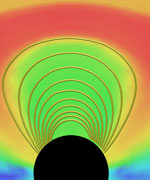
Image credit: NASA
New research indicates that electrons may surf on magnetic waves driven by the solar wind, and get accelerated to the point they can cause some serious damage to spacecraft orbiting the Earth. The process is a result of the interaction between the Earth’s magnetic field and fluctuations in the density of the solar wind. As the density of the solar wind changes, it causes waves in the magnetic field to ripple back to the Earth. Electrons can be caught in these ripples and surf back to the Earth so fast they can damage delicate electronics in space.
“Killer” electrons capable of wreaking havoc on orbiting spacecraft may “surf” magnetic waves driven by the solar wind, according to a team of space scientists.
The team from Boston University and the National Oceanic and Atmospheric Administration (NOAA) combined observations from NASA and NOAA spacecraft to identify a phenomenon that explains how the solar wind makes waves in Earth’s magnetic field (magnetosphere). Ordinary electrons orbiting the Earth in the Van Allen radiation belts may boogyboard the waves, accelerating to near the speed of light, with energies 300-500 times greater than the electrons in a television screen.
The solar wind is a stream of electrically charged particles blown constantly from the Sun. The magnetosphere is a cavity formed when the solar wind encounters the Earth’s magnetic field. When the solar wind density is high and comes up against the magnetosphere, the magnetosphere gets compressed. When the wind density is low, the magnetosphere expands. The researchers discovered that the solar wind contains periodic structures of high and low density, driving a periodic “breathing” action of the magnetosphere and the global generation of magnetic waves.
It’s known that if the frequency of these waves matches the frequency of the electrons in their motion in the Van Allen belt, the electrons can be accelerated, significantly boosting their energies. The process is similar to a boogyboarder catching a wave. Some electrons “ride the wave” and gain so much energy that they can then damage expensive spacecraft.
“If we can confirm this as a significant mechanism for making the waves that accelerate ‘killer’ electrons, then scientists using data from satellites like Wind could develop advance warning for spacecraft operators that their spacecraft may be in danger of excessive and damaging radiation exposure,” said Dr. Barbara Giles, project scientist for the Polar spacecraft at NASA’s Goddard Space Flight Center, Greenbelt, Md.
When electrons become this energetic, they can penetrate to the interior of spacecraft. Once inside electronic parts, they build up static electricity that can short circuit a critical part or put the spacecraft into a bad operating mode.
“What’s new and exciting about this research is that people had always looked for mechanisms internal to the magnetosphere for generating these waves,” said Dr. Larry Kepko, research associate at Boston University and lead author of two papers on this research, one published in the Journal of Geophysical Research in June 2003 and the other in Geophysical Research Letters in 2002. “But here we’ve found an external mechanism – the solar wind itself.”
NASA’s Polar and Wind satellites, along with NOAA’s Geostationary Operational Environmental Satellite (GOES), provided the key observations leading the team to this conclusion. Polar confirmed that the waves are not local, but global. The Wind satellite was the primary source for identifying the density structures in the solar wind that drive the magnetosphere. GOES provided data about the Earth’s magnetosphere as it increased and decreased in size.
“We already knew that the solar wind has density structures and that magnetic waves can accelerate electrons,” said Dr. Harlan Spence, associate professor of astronomy at Boston University and co-author of the two papers on this research. “What we didn’t know was that the solar wind structures can be periodic and drive magnetic waves. These new observations may provide a missing link between the two.”
The ultimate source of these newly discovered solar wind structures is still a mystery, but the team speculates that the Sun may play a direct role. “The solar wind density variations are partly controlled by the pattern of magnetic reconnection, the twisting and snapping of magnetic field lines, on the surface of the Sun,” says Dr. Kepko. “Reconnection occurring in a systematic, periodic manner may produce the observed periodic density structures in the solar wind. There is some evidence that this may be occurring, but further research is required to establish a definitive link.”
The Van Allen radiation belts were discovered in 1958 by Dr. James Van Allen and his team at the University of Iowa with Explorers 1 and 3, the first satellites successfully launched by the United States. They are belts of electrically charged particles trapped by the Earth’s magnetic field. Since the particles are electrically charged (mostly protons and electrons), they feel magnetic forces and are constrained to spiral around invisible lines of magnetic force that comprise the Earth’s magnetic field. There are actually two donut-shaped belts in the Van Allen system, one inside the other with the Earth in the “hole” of the inner belt. The inner belt, made up of high-speed protons, is located at altitudes between 430 and 7,500 miles (about 700 to 12,000 km) above the Earth. The outer belt is made of high-speed electrons and appears at altitudes between 15,500 and 25,000 miles (about 25,000 to 40,000 km) above Earth. Spacecraft operators try to avoid orbits in these regions, but sometimes these altitudes are best for a particular mission, or the spacecraft must pass through the belts during part of its orbit or to escape the Earth entirely.
NASA’s Polar and Wind satellites, together known as the “Global Geospace Science Program,” are dedicated to helping scientists understand how particles and energy from the Sun flow through, and interact with, the Earth’s space environment.
NOAA is dedicated to gathering data about the oceans, the atmosphere, space, and the Sun. Its GOES satellite system is the basic element for U.S. weather monitoring and forecasting. Dr. Howard Singer from NOAA is a third co-author on the 2002 paper about this research.
Original Source: NASA News Release
Sunlight Spins Asteroids
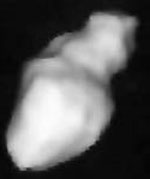
Image credit: NASA/JPL
Astronomers have long-held that collisions were the primary cause of spinning asteroids, but new research indicates that it might be something much more gentle: sunlight. In a recent study carried out by the Southwest Research Institute (SwRI) and Charles University (Prague), astronomers calculated the effect of millions and even billions of years of sunlight pressure can cause an asteroid to spin so fast it can fly apart; others can be made to stop spinning completely.
A new study by researchers at Southwest Research Institute (SwRI) and Charles University (Prague) has found that sunlight can have surprisingly important effects on the spins of small asteroids. The study indicates that sunlight may play a more important role in determining asteroid spin rates than collisions, which were previously thought to control asteroid spin rates. Results will be published in the Sept. 11 issue of Nature.
David Vokrouhlicky (Charles University), David Nesvorny and William Bottke (both of the SwRI Space Studies Department) conducted the study, which showed that sunlight absorbed and reemitted over millions to billions of years can spin some asteroids so fast they could potentially break apart. In other cases, it can nearly stop them from spinning altogether. The team even noted that the effects of sunlight, combined with the gravitational tugs of the planets, can slowly force asteroid rotation poles to point in the same direction.
Until recently, researchers thought asteroid impacts controlled the rotation speed and direction of small asteroids floating in space. The unusual spin states of 10 asteroids observed by Stephen Slivan, a researcher at the Massachusetts Institute of Technology, however, have cast doubt on this idea. Slivan’s asteroids, the first in the 15- to 25-mile-diameter range to have their spins extensively studied, are in the so-called Koronis asteroid family, a cluster of asteroid fragments produced by a highly energetic collision billions of years ago. Slivan found that not only do four of these asteroids rotate at nearly the same speed, but they also have spin axes that point in the same direction.
“The data clearly show that the spin vector alignment is real, but how they got that way has been a big puzzle,” says Slivan. “I’m delighted that others find this to be an interesting problem.”
“To picture just how weird these asteroids really are, imagine you were handed a box of spinning tops just as you were about to launch aboard the space shuttle. Given all the shaking produced by the launch, you would expect the tops to have different spin speeds and orientations by the time you reached orbit,” says Bottke. “Instead, imagine your surprise upon opening the box if the tops were all spinning at the same speed and had their handles pointing toward the constellation Cassiopeia. Now increase the size of the tops by a factor of a million and pretend that the bouncing during launch is equivalent to billions of years of asteroid collisions. This is the strange situation we find ourselves with.”
The remaining six asteroids studied by Slivan either have extremely slow spin rates, such that they rotate slower than the hour hand of a clock, or very fast spin rates, such that they are near the limit beyond which loose material on the surface of an asteroid would fly off.
“One would expect that collisions would have randomized these rotation rates. It was a big surprise to find a cluster of asteroids with such odd spin states,” says Nesvorny.
To explain the spin states of Koronis family asteroids, Vokrouhlicky, Nesvorny and Bottke investigated how asteroids reflect and absorb light from the sun and reradiate this energy away as heat. They found that while the recoil force produced by the reradiation of sunlight is tiny, it can still substantially alter an asteroid’s rotation rate and pole direction if it has enough time to act.
“Like the story about the tortoise and the hare, slow and steady sunlight wins the race over the fast-acting, but less effective, jolt of collisions between asteroids. Sunlight in space never stops,” says Bottke, “and most asteroids have been exposed to a lot of it because of their age.”
Using computer simulations, the team showed that sunlight has been slowly increasing and decreasing the rotation rates of Koronis family asteroids since they were formed 2 to 3 billion years ago. More remarkably, they found that some simulated asteroids were captured into a special spin state that forced the wobble of the asteroid’s spin axis (produced by gravitational perturbations from the sun) to “beat” at the same frequency as the wobble of the asteroid’s orbit (produced by gravitational perturbations from the planets). This state, called a spin-orbit resonance, can drive an asteroid’s rotation rate and spin axis to particular values.
“These results give us a new way to look at the asteroids,” says Vokroulicky. “It is our hope that this work will stimulate observational studies into many different regions of the main asteroid belt. We have only scratched the surface of this interesting problem.”
Original Source: SWRI News Release
Hubble Helps Prepare Rosetta Mission
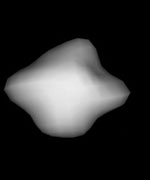
Image credit: ESA
The Hubble Space Telescope has been making detailed observations of Comet 67P/Churyumov-Gerasimenko – the new target for the European Space Agency’s Rosetta mission. The data from Hubble has helped the ESA make precise measurements of the comet’s shape, size and spin-rate so they can fine-tune Rosetta’s flight. If all goes well, Rosetta will launch on February 26, 2004, and then take 10 years to reach the comet. It will orbit the comet and then drop a scientific package onto the surface which should provide scientists with plenty of new data.
Results from the NASA/ESA Hubble Space Telescope have played a major role in preparing ESA?s ambitious Rosetta mission for its new target, comet 67P/Churyumov-Gerasimenko.
Hubble has been used to make precise measurements of the size, shape and rotational period of the comet. Information that is essential if Rosetta is to rendezvous with the comet and then drop down a probe, something never before attempted and yet a major step towards elucidating the origins of the solar system.
Observations made by Hubble in March this year revealed that comet 67P/Churyumov-Gerasimenko (67P/C-G) is approximately five by three kilometres in size and shaped like a rugby ball. ESA mission scientists were concerned about the exact size of the solid nucleus, which is needed to adapt the mission to the comet?s gravity.
“Although 67P/C-G is roughly three times larger than the original Rosetta target, its highly elongated shape should make landing on its nucleus feasible, now that measures are in place to adapt the lander package to the new scenario,” says Dr Philippe Lamy of the Laboratoire d’Astronomie Spatiale in France, who is presenting the Hubble results on comet 67P/C-G today at the annual meeting of the Division for Planetary Sciences of the American Astronomical Society in California, USA.
Mission scientists began looking for an alternative target when the Rosetta mission’s launch date was postponed. The delay meant that the original target comet, 46P/Wirtanen, was no longer easily reachable. But scientists did not have enough information on the back-up comet, 67P/C-G, and sought data from the largest telescopes.
Using a technique developed over the past decade by Philippe Lamy, Imre Toth (Konkoly Observatory, Hungary), and Harold Weaver (Johns Hopkins University Applied Physics Laboratory, Laurel, USA), the team snapped 61 Hubble images of comet 67P/C-G over a period of 21 hours on 11 and 12 March. Hubble’s Wide Field Planetary Camera 2 isolated the comet’s nucleus from the coma, the diffuse gas surrounding the nucleus, quickly providing the figures required. The telescope showed that the nucleus is ellipsoidal and measured its rotation rate at approximately 12 hours.
Rosetta’s launch is currently planned for February 2004, with a rendezvous with the comet about 10 years later.
Original Source: ESA News Release
Shuttles Will Return to Flight in March
NASA representatives met with the media on Monday and announced that the space shuttle would begin operations again some time between March 11 and April 6. Several safety changes are going to be made before the first shuttle, Atlantis, launches to visit the International Space Station: the bipod ramp (which shed foam on the Columbia launch) will be redesigned, and launch windows will only be in the day so cameras can track the launch. Perhaps the biggest changes, however, will come from NASA’s attempts to change its culture to improve safety. “We will be safety driven, not schedule driven.”
Three Views of Saturn
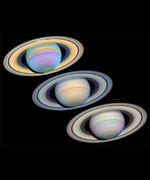
Image credit: Hubble
The planet Saturn reached its maximum tilt towards the Earth last Spring, and astronomers took advantage of the situation to image the ringed planet in three wavelengths of light using the Hubble Space Telescope: ultraviolet, visible, and infrared. Saturn tilts at an angle of 26-degrees and experiences seasons in its hemispheres like the Earth as it travels around the Sun; its orbit takes nearly 30 years. Particles in Saturn’s atmosphere reflect different wavelights of light differently, so the different images can help fill in pieces of missing information.
This is a series of images of Saturn, as seen at many different wavelengths, when the planet’s rings were at a maximum tilt of 26 degrees toward Earth. Saturn experiences seasonal tilts away from and toward the Sun, much the same way Earth does. This happens over the course of its 29.5-year orbit. This means that approximately every 30 years, Earth observers can catch their best glimpse of Saturn’s South Pole and the southern side of the planet’s rings. Between March and April 2003, researchers took full advantage to study the gas giant at maximum tilt. They used NASA’s Hubble Space Telescope to capture detailed images of Saturn’s Southern Hemisphere and the southern face of its rings.
The telescope’s Wide Field Planetary Camera 2 used 30 filters to snap these images on March 7, 2003. The filters span a range of wavelengths. “The set of 30 selected filters may be the best spectral coverage of Saturn observations ever obtained,” says planetary researcher Erich Karkoschka of the University of Arizona. Various wavelengths of light allow researchers to see important characteristics of Saturn’s atmosphere. Particles in Saturn’s atmosphere reflect different wavelengths of light in discrete ways, causing some bands of gas in the atmosphere to stand out vividly in an image, while other areas will be very dark or dull. One image cannot stand by itself because one feature may have several interpretations. In fact, only by combining and comparing these different images, in a set such as this one, can researchers interpret the data and better understand the planet.
By examining the hazes and clouds present in these images, researchers can learn about the dynamics of Saturn’s atmosphere. Scientists gain insight into the structure and gaseous composition of Saturn’s clouds via inspection of images such as these taken by the Hubble telescope. Over several wavelength bands, from infrared to ultraviolet, these images reveal the properties and sizes of aerosols in Saturn’s gaseous makeup. For example, smaller aerosols are visible only in the ultraviolet image, because they do not scatter or absorb visible or infrared light, which have longer wavelengths. By determining the characteristics of the atmosphere’s constituents, researchers can describe the dynamics of cloud formation. At certain visible and infrared wavelengths, light absorption by methane gas blocks all but the uppermost layers of Saturn’s atmosphere, which helps researchers discern clouds at different altitudes. In addition, when compared with images of Saturn from seasons past (1991 and 1995), this view of the planet also offers scientists a better comprehension of Saturn’s seasonal changes.
Original Source: Hubble News Release
Hubble Sees Distant Icy Objects
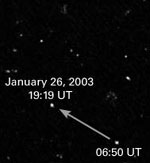
Image credit: Hubble
Using the Hubble Space Telescope, astronomers have discovered three of the faintest and small objects ever seen in the Outer Solar System. Each object is a lump of ice and rock, called a Kuiper Object, that could date back to the creation of the Solar System, 4.5 billion years ago. What’s surprising, however, is how few Kuiper Objects the team discovered. They were expecting to find 60 as small as 15 km in the field they surveyed, but only turned up 3.
Astronomers using NASA’s Hubble Space Telescope have discovered three of the faintest and smallest objects ever detected beyond Neptune. Each object is a lump of ice and rock ? roughly the size of Philadelphia ? orbiting beyond Neptune and Pluto, where the icy bodies may have dwelled since the formation of the solar system 4.5 billion years ago. They reside in a ring-shaped region called the Kuiper Belt, which houses a swarm of icy rocks that are leftover building blocks, or “planetesimals,” from the solar system’s creation.
The results of the search were announced by a group led by astronomer Gary Bernstein of the University of Pennsylvania at today’s meeting of the Division of Planetary Sciences in Monterey, Calif.
The study’s big surprise is that so few Kuiper Belt members were discovered. With Hubble’s exquisite resolution, Bernstein and his co- workers expected to find at least 60 Kuiper Belt members as small as 10 miles (15 km) in diameter ? but only three were discovered.
“Discovering many fewer Kuiper Belt objects than was predicted makes it difficult to understand how so many comets appear near Earth, since many comets were thought to originate in the Kuiper Belt,” Bernstein says. “This is a sign that perhaps the smaller planetesimals have been shattered into dust by colliding with each other over the past few billion years.”
Bernstein and his colleagues used Hubble to look for planetesimals that are much smaller and fainter than can be seen from ground-based telescopes. Hubble’s Advanced Camera for Surveys was pointed at a region in the constellation Virgo over a 15-day period in January and February 2003. A bank of 10 computers on the ground worked for six months searching for faint-moving spots in the Hubble images.
The search netted three small objects, named 2003 BF91, 2003 BG91, and 2003 BH91, which range in size from 15-28 miles (25-45 km) across. They are the smallest objects ever found beyond Neptune. At their current locations, these icy bodies are a billion times fainter (29th magnitude) than the dimmest objects visible to the naked eye. But an icy body of this size that escapes the Kuiper Belt to wander near the Sun can become visible from Earth as a comet as the wandering body starts to evaporate and form a surrounding cloud.
Astronomers are probing the Kuiper Belt because the region offers a window on the early history of our solar system. The planets formed over 4 billion years ago from a cloud of gas and dust that surrounded the infant Sun. Microscopic bits of ice and dust stuck together to form lumps that grew from pebbles to boulders to city- or continent-sized planetesimals. The known planets and moons are the result of collisions between planetesimals. In most of the solar system, all of the planetesimals have either been absorbed into planets or ejected into interstellar space, destroying the traces of the early days of the solar system.
Around 1950, Gerard Kuiper and Kenneth Edgeworth proposed that in the region beyond Neptune there are no planets capable of ejecting the leftover planetesimals. There should be a zone, the two astronomers said? now called the Kuiper Belt ? filled with small, icy bodies. Despite many years of searching, the first such object was not found until 1992. Since then, astronomers have discovered nearly 1,000 from ground-based telescopes. Most astronomers now believe that Pluto, discovered in 1930, is in fact a member of the Kuiper Belt.
Astronomers now use the Kuiper Belt to learn about the history of the solar system, much as paleontologists use fossils to study early life. Each event that affected the outer solar system ? such as possible gravitational disturbances from passing stars or long-vanished planets ? is frozen into the properties of the Kuiper Belt members that astronomers see today.
If the Hubble telescope could search the entire sky, it would find perhaps a half million planetesimals. If collected into a single planet, however, the resulting object would be only a few times larger than Pluto. The new Hubble observations, combined with the latest ground-based Kuiper Belt surveys, reinforce the idea that Pluto itself and its moon Charon are just large Kuiper Belt members. Why the Kuiper Belt planetesimals did not form a larger planet, and why there are fewer small planetesimals than expected, are questions that will be answered with further Kuiper Belt studies. These studies will help astronomers understand how planets may have formed around other stars as well.
The new Hubble results were reported by Bernstein and David Trilling (University of Pennsylvania); Renu Malhotra (University of Arizona); Lynne Allen (University of British Columbia); Michael Brown (California Institute of Technology); and Matthew Holman (Harvard-Smithsonian Center for Astrophysics). The results have been submitted to the Astronomical Journal for publication, and a preliminary report is available on the Web at http://arxiv.org/abs/astro-ph/0308467.
Original Source: Hubble News Release
Senate Approves $15.3 Billion Budget for NASA
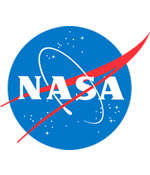
Image credit: NASA
On the heels of the release of the Columbia Accident Investigation report, the United Stats Senate Appropriations Committee approved NASA’s $15.3 billion budget for 2004. There were only a few differences from this budget and the $15.5 billion requested by President Bush earlier this year. $200 million was cut in from the International Space Station because of the smaller crew and use of Soyuz spacecraft. $20 million was cut from the Jupiter Icy Moons Orbiter (JIMO) mission; although, the explained that this amount had been added last year and not used. There were no other major cuts or changes to NASA’s budget.
? The bill has NASA funded at $15.3 billion. This is the same as the amount enacted in FY 2003.
? The Human Space Flight makes no changes to the funding in the Shuttle account, but are encourages NASA to keep Congress notified of any changes to this program resulting from the Columbia Accident Investigation Board (CAIB). The report requires NASA to provide a comprehensive plan within 4 months regarding response to the CIAB, as well as a 10-year funding profile for all of Shuttle fleet as safe and the proposed changes. The report expresses concern over what the impacts of the CAIB recommendations will be, and if there is a restructuring at NASA, what the long-term implications of a reorganization may be. We are also making limitations that will not allow NASA to move funds away from the Shuttle program.
? The bill includes a reduction of $200 million for the International Space Station (ISS). With the current situation aboard the station of a reduced crew and Russians supplying vehicles for crew and cargo transfer, there are other pressing needs within NASA and the bill for funds. At this time, NASA is unsure as to when the ISS will be operating with a crew of three, it may only be for a few more months or it could be longer than a year. The ISS has reserves of over $250 million and should be able to cover this modest reduction.
? The Science, Aeronautics, and Exploration fund is funded at the request with the exception of a $20 million reduction for the Jupiter Icy Moons Orbiter. This reduction corresponds to a similar amount funded into the program last year, but that was not requested. The result is that the funding for the program is equal to the FY 2004 request, but is spread over two fiscal years, but actually 8 calendar months. There is also $50 million in additional funds that go towards aeronautics research. The bill also has some other minor adjustments to other programs, but there are no major cuts or terminations to any programs within this portion of the bill.
? NASA has come to the Committee in the recent past about various human capitol issues, including retention bonuses and increased buyout authority. The bill asks for NASA to report on what they feel the budgetary impacts of such practices will be, both initially and over the long term. The bill includes a requirement that the National Academy of Public Administration do a top to bottom management analysis of NASA, particularly in response to the CAIB report which cited NASA management and culture as being a factor in the Columbia accident.
Source: US Press Release
Asteroids are Probably a Threat. Maybe?
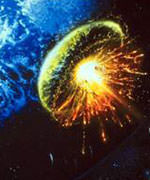
Image credit: NASA
As potentially killer asteroids are announced on an almost yearly basis, the public is started to get a little jaded about the risks humanity faces. How can governments and space agencies confront a threat that can only be a “maybe” until it’s too late to do anything about it? Here’s my opinion.
Well, you can all breath a sigh of relief, 2003 qq47 isn’t going to smash into Earth on March 21, 2014 and cause widespread death and destruction. But then, if you’ve been a regular follower of space news, you’re probably not really surprised. Astronomers release a warning almost every year that a space rock has some outside chance of striking the Earth, and then revise their estimates shortly afterwards thanks to more observations.
The first big rock to freak out the public was Asteroid 1997 XF11; it was supposed to strike the Earth in October 26, 2028. Even though the original threat was still remote, the mass media picked up on this. There were full-page articles in major newspapers, the cover of magazines, and on the evening news. Astronomers quickly followed up the story with a retraction. Not only would XF11 miss the Earth, it would miss by almost a million kilometres, or 2.5 times further than the Moon.
New reports of killer asteroids have come out in the following years, with wiser astronomers being a little more conservative in their predictions. With QQ47, the first stories pegged the chances of a strike at 1 in 909,000; not much higher than the background risk that the Earth faces every year from getting hit by an asteroid. The risk has since been downgraded.
As automated asteroid searches continue to search the sky, potential planet smashers are going to be spotted quite regularly. Astronomers will provide conservative calculations, and a jaded public will treat each announcement with even more skepticism. When the 37th potential killer asteroid is announced, it’ll make little more than a blip in the general media – that’s understandable.
The unspoken goal for finding asteroids is to prevent one of them from ever striking the Earth and causing damage. In theory, the sooner you find a killer asteroid, the longer you have to adjust its orbit and save the Earth from destruction. If a collision is only a couple of months away, there’s little to do but prepare for the worst. But if it’s years or even decades away, spacecraft could be launched to nudge the asteroid into a less hazardous trajectory.
Astronomers are going to keep a watchful eye on the sky, to alert governments and the public to any future risks. But the problem is that astronomers deal in probabilities. They won’t say a certain asteroid WILL hit the Earth (like in Armageddon); instead they’ll say that it can hit the Earth.
That it may hit the Earth.
Will governments and space agencies be decisive enough to spend billions of dollars changing an asteroid’s orbit when they aren’t sure it’s even necessary. The longer you wait, the better the calculations become, but the less time you have to defend against it. With more data, astronomers will likely be tracking dozens of potential Earth-crossers with varying risks and dates that they’ll strike our planet. How do we decide which asteroids need to be moved and which can wait?
I don’t think we’re ever going to have a clear-cut challenge that will unite humanity against a common threat. If we did, it would probably only be months away and there’d be little we could do about it. Just take a look at global warming. Even though the evidence seems to be saying that humans have warmed the planet a degree in the last century, the worldwide response is denial and procrastination.
So what’s the solution? I honestly don’t know if governments and space agencies can really get organized and decisive around such a nebulous threat (the threat is real, though, with the potential for unlimited damage). Investing in basic research is probably the best solution; better funding for observatories to discover and map asteroid trajectories; new propulsion systems that could help push an asteroid out of the way. Maybe if engineers deliver better solutions, it will help procrastinating governments take action at the last minute.
Keck Gets a Clear View of Asteroid (511) Davida
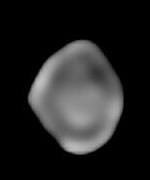
Image credit: Keck
A team of astronomers have used the 10-metre Keck II telescope to create a series of images that show asteroid (511) Davida from every angle. The images of the 320 km asteroid were taken in late December, 2002 using the Keck’s adaptive optics system – a special technology that allows the telescope to compensate for distortion caused by the Earth’s atmosphere. The observations are so precise that features as small as 46 km can be seen on the surface of the asteroid.
A team of scientists from the W.M. Keck Observatory and several other research institutions have made the first full-rotational, ground-based observations of asteroid (511) Davida, a large, main-belt asteroid that measures 320 km (200 miles) in diameter. These observations are among the first high-resolution, ground-based pictures of large asteroids, made possible only through the use of adaptive optics on large telescopes. This research will help improve understanding of how asteroids were formed and provide information about their compositions and structures. Because the asteroids were formed and shaped by collisions, a process that also affected the Earth, Moon, and planets, these studies will also help astronomers understand the history and evolution of the solar system.
” Asteroid Davida was discovered 100 years ago, but this is the first time anyone has been able to see this level of detail on this object,” said Dr. Al Conrad, scientist at the W.M. Keck Observatory. “With adaptive optics, we’re finally able to transform asteroids like Davida from a single, faint point-source into an object of true geological study.”
Ground-based observations of large, main-belt asteroids are made possible only through a powerful astronomical technique called adaptive optics, which removes the blurring caused by Earth’s atmosphere. Without adaptive optics, critical surface information and details about the asteroid’s shape are lost. The techniques used at the W.M. Keck Observatory allow astronomers to measure the distortion of light caused by the atmosphere and rapidly make corrections, restoring the light to near-perfect quality. Such corrections are most easily made to infrared light. In many cases, infrared observations made with Keck adaptive optics are better than those obtained with space-based telescopes.
The observations of asteroid (511) Davida were made with the 10-meter (400-inch) Keck II telescope on December 26, 2002. Images were taken over a full rotation period of about 5.1 hours, just a few days before its closest approach to Earth. At that time, Davida’s angular diameter was less than one-ten-thousandth of a degree, about the size of a quarter as seen from a distance of 18 kilometers (11 miles). The high angular resolution allowed astronomers to see surface details as small as 46 kilometers (30 miles), about the size of the San Francisco Bay area. The next time Davida comes this close to Earth will be in the year 2030.
At the time of the observations, Davida?s north pole faced Earth. While scientists could see the asteroid spinning, only the northern hemisphere was visible. Yet the profile of the asteroid is far from circular: At least two flat facets can be seen on its surface. Although scientists knew previously from light variations that Davida must have an oblong shape, details of that shape were not available until now. Initial evaluation of the images reveal some dark features, and scientists are still working to understand to what extent these are surface markings, topographical features, or artifacts of the image processing.
” Adaptive optics on large telescopes is allowing us to make detailed studies from the ground that were previously impossible or prohibitively expensive,” said Dr. William Merline, principal scientist with the Southwest Research Institute, and a participant in this research. “We can now make observations that once required either the scarce resources of space telescopes or spacecraft missions to asteroids. While these space telescopes and space missions are still needed for complete study of the asteroids, ground-based observations such as these will help tremendously in planning the mission observations and focusing the resources where they will be most effective.”
Asteroids are the collection of rocky objects orbiting between Mars and Jupiter. They were likely prevented from forming into a planet, partly due to Jupiter’s massive gravitational influence.
? Although the asteroids began their lives colliding gently, in a way that would lead them eventually to form a planet, Jupiter’s gravity eventually stirred up their orbits, and they began to collide at higher speeds,? added participant Dr. Christophe Dumas, planetary astronomer with the Jet Propulsion Laboratory. ?These collisions tended to cause them to break up rather than gently stick together. The resulting fragments, numbering in the hundreds of thousands, are the asteroids we see today. They collide with each other and have impacted the Earth, Moon, and planets over time. One need only look at the scarred surface of our Moon to see the cumulative result. Study of the asteroid’s shape, size, and surface features helps us understand how these collisions operate and thus how our planet was, and still is, being affected by these impacts.?
Observations of the shapes of asteroids, such as those released today, can tell us about the types and severity of impacts that occurred, and possibly also give clues into the overall structure of an asteroid — for example, whether it may be solid rock, or a jumble of smaller rocks. Surface features can reveal a history of large impacts or variations in the composition that should, in turn, further help us understand the asteroid’s history.
Asteroid (511) Davida was discovered by R. S. Dugan in 1903 in Heidelberg, Germany. The (511) in Davida’s name means it was the 511th asteroid to be discovered and included in the list of asteroids maintained by the International Astronomical Union.
Team members responsible for the observations are Al Conrad, David Le Mignant, Randy Campbell, Fred Chaffee, Robert Goodrich, Shui Kwok of the W.M. Keck Observatory; Christophe Dumas, Jet Propulsion Laboratory; William Merline, Southwest Research Institute; Heidi Hammel, Space Science Institute; and Thierry Fusco, Onera, France.
The W.M. Keck Observatory is operated by the California Association for Research in Astronomy, a scientific partnership of the California Institute of Technology, the University of California, and the National Aeronautics and Space Administration.
Source: Keck Press Release
